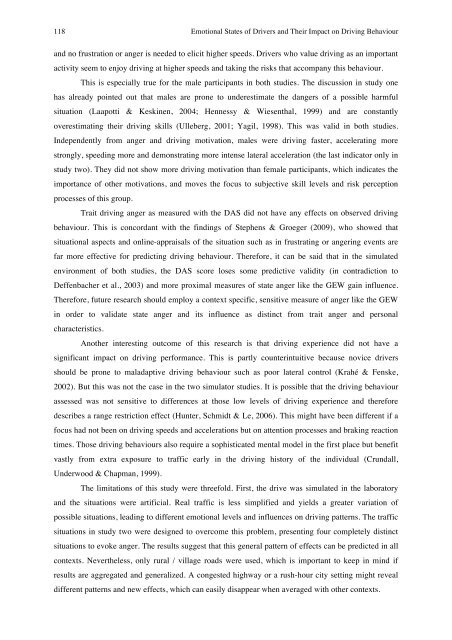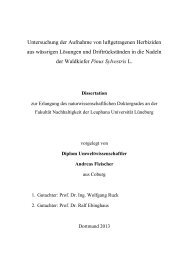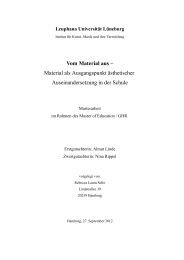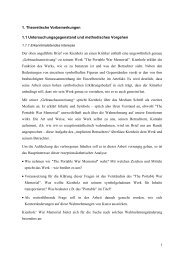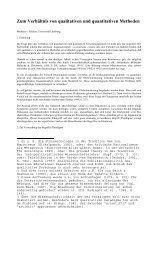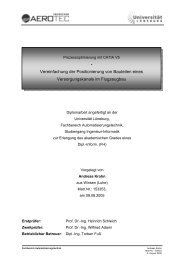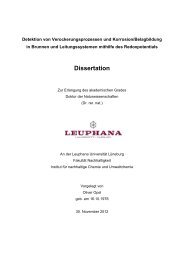Determinants of Emotional Experiences in Traffic Situations ... - OPUS
Determinants of Emotional Experiences in Traffic Situations ... - OPUS
Determinants of Emotional Experiences in Traffic Situations ... - OPUS
You also want an ePaper? Increase the reach of your titles
YUMPU automatically turns print PDFs into web optimized ePapers that Google loves.
118 <strong>Emotional</strong> States <strong>of</strong> Drivers and Their Impact on Driv<strong>in</strong>g Behaviour!<br />
and no frustration or anger is needed to elicit higher speeds. Drivers who value driv<strong>in</strong>g as an important<br />
activity seem to enjoy driv<strong>in</strong>g at higher speeds and tak<strong>in</strong>g the risks that accompany this behaviour.<br />
This is especially true for the male participants <strong>in</strong> both studies. The discussion <strong>in</strong> study one<br />
has already po<strong>in</strong>ted out that males are prone to underestimate the dangers <strong>of</strong> a possible harmful<br />
situation (Laapotti & Kesk<strong>in</strong>en, 2004; Hennessy & Wiesenthal, 1999) and are constantly<br />
overestimat<strong>in</strong>g their driv<strong>in</strong>g skills (Ulleberg, 2001; Yagil, 1998). This was valid <strong>in</strong> both studies.<br />
Independently from anger and driv<strong>in</strong>g motivation, males were driv<strong>in</strong>g faster, accelerat<strong>in</strong>g more<br />
strongly, speed<strong>in</strong>g more and demonstrat<strong>in</strong>g more <strong>in</strong>tense lateral acceleration (the last <strong>in</strong>dicator only <strong>in</strong><br />
study two). They did not show more driv<strong>in</strong>g motivation than female participants, which <strong>in</strong>dicates the<br />
importance <strong>of</strong> other motivations, and moves the focus to subjective skill levels and risk perception<br />
processes <strong>of</strong> this group.<br />
Trait driv<strong>in</strong>g anger as measured with the DAS did not have any effects on observed driv<strong>in</strong>g<br />
behaviour. This is concordant with the f<strong>in</strong>d<strong>in</strong>gs <strong>of</strong> Stephens & Groeger (2009), who showed that<br />
situational aspects and onl<strong>in</strong>e-appraisals <strong>of</strong> the situation such as <strong>in</strong> frustrat<strong>in</strong>g or anger<strong>in</strong>g events are<br />
far more effective for predict<strong>in</strong>g driv<strong>in</strong>g behaviour. Therefore, it can be said that <strong>in</strong> the simulated<br />
environment <strong>of</strong> both studies, the DAS score loses some predictive validity (<strong>in</strong> contradiction to<br />
Deffenbacher et al., 2003) and more proximal measures <strong>of</strong> state anger like the GEW ga<strong>in</strong> <strong>in</strong>fluence.<br />
Therefore, future research should employ a context specific, sensitive measure <strong>of</strong> anger like the GEW<br />
<strong>in</strong> order to validate state anger and its <strong>in</strong>fluence as dist<strong>in</strong>ct from trait anger and personal<br />
characteristics.<br />
Another <strong>in</strong>terest<strong>in</strong>g outcome <strong>of</strong> this research is that driv<strong>in</strong>g experience did not have a<br />
significant impact on driv<strong>in</strong>g performance. This is partly counter<strong>in</strong>tuitive because novice drivers<br />
should be prone to maladaptive driv<strong>in</strong>g behaviour such as poor lateral control (Krahé & Fenske,<br />
2002). But this was not the case <strong>in</strong> the two simulator studies. It is possible that the driv<strong>in</strong>g behaviour<br />
assessed was not sensitive to differences at those low levels <strong>of</strong> driv<strong>in</strong>g experience and therefore<br />
describes a range restriction effect (Hunter, Schmidt & Le, 2006). This might have been different if a<br />
focus had not been on driv<strong>in</strong>g speeds and accelerations but on attention processes and brak<strong>in</strong>g reaction<br />
times. Those driv<strong>in</strong>g behaviours also require a sophisticated mental model <strong>in</strong> the first place but benefit<br />
vastly from extra exposure to traffic early <strong>in</strong> the driv<strong>in</strong>g history <strong>of</strong> the <strong>in</strong>dividual (Crundall,<br />
Underwood & Chapman, 1999).<br />
The limitations <strong>of</strong> this study were threefold. First, the drive was simulated <strong>in</strong> the laboratory<br />
and the situations were artificial. Real traffic is less simplified and yields a greater variation <strong>of</strong><br />
possible situations, lead<strong>in</strong>g to different emotional levels and <strong>in</strong>fluences on driv<strong>in</strong>g patterns. The traffic<br />
situations <strong>in</strong> study two were designed to overcome this problem, present<strong>in</strong>g four completely dist<strong>in</strong>ct<br />
situations to evoke anger. The results suggest that this general pattern <strong>of</strong> effects can be predicted <strong>in</strong> all<br />
contexts. Nevertheless, only rural / village roads were used, which is important to keep <strong>in</strong> m<strong>in</strong>d if<br />
results are aggregated and generalized. A congested highway or a rush-hour city sett<strong>in</strong>g might reveal<br />
different patterns and new effects, which can easily disappear when averaged with other contexts.


